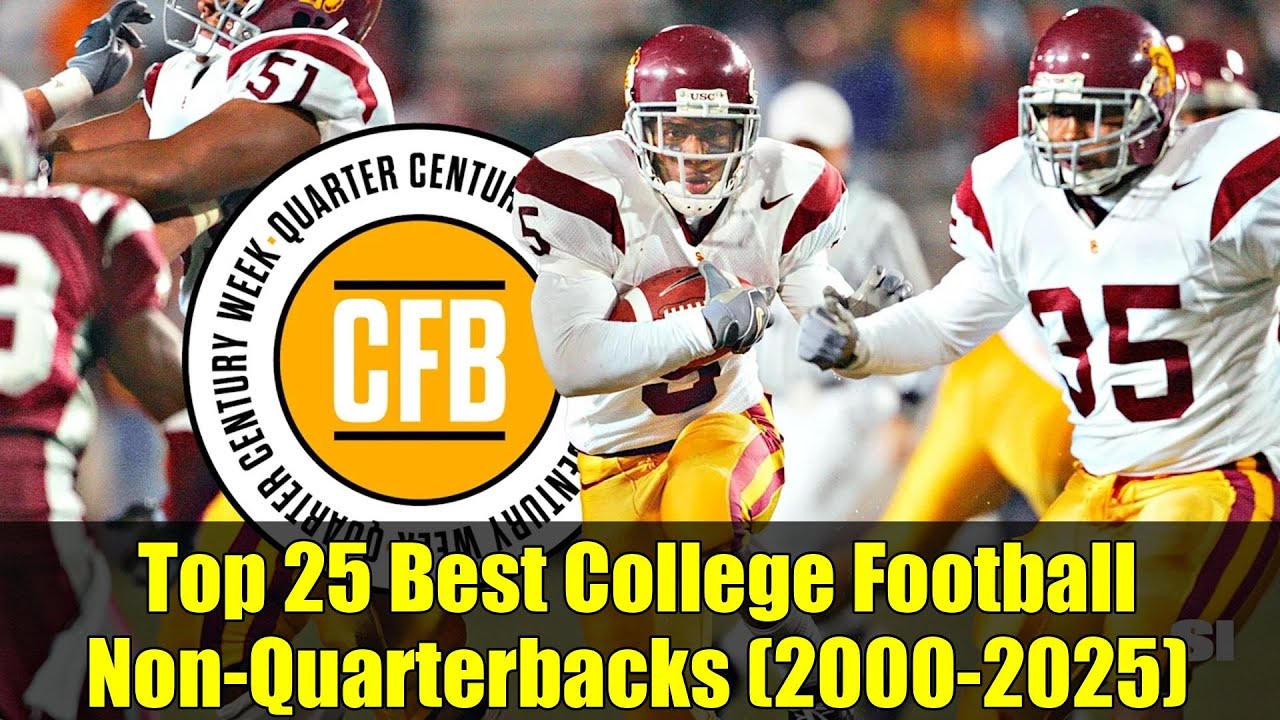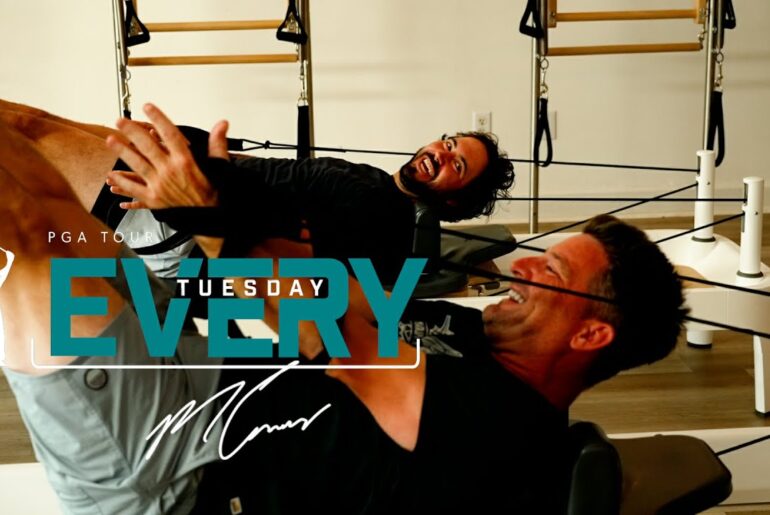00:00 – Top 25 Best College Football Non-Quarterbacks (2000-2025) | Greatest Players Ranked
13:14 – The Top 25 College Football Quarterbacks of the Past 25 Years
26:22 – Top 25 College Football Players Since 2000: CFB All-Quarter Century Team
1. Top 25 Best College Football Non-Quarterbacks (2000-2025) | Greatest Players Ranked
Discover the 25 best college football players who weren’t quarterbacks from the past 25 years. From Heisman winners to game-changing defenders and versatile stars like Reggie Bush, Travis Hunter, Ndamukong Suh, and Christian McCaffrey, we highlight the greatest non-QB talents in college football history. Learn about their record-breaking seasons, standout plays, and awards that defined this quarter-century of college football.
Keywords: College football best players, non-quarterbacks, college football history, Reggie Bush highlights, Travis Hunter Heisman, Ndamukong Suh defense, college football awards, Heisman winners non-QB, Christian McCaffrey all-purpose yards, top college football careers, NCAA football legends, best tight ends, best defensive players in college football.
For fans and analysts wanting to know who shaped college football beyond the quarterback position in the 21st century, this is your definitive list and analysis.
2. The Top 25 College Football Quarterbacks of the Past 25 Years
In this video, we’ll be counting down the top 25 college football quarterbacks of the past 25 years. From Joe Burrow to Tim Tebow, we’ll be looking at the best of the best and what made them so great. Whether you’re a fan of the SEC, Big 12, or Pac-12, this video is for you.
We’ll be discussing their stats, awards, and accolades, as well as their impact on their teams and the sport as a whole. So, if you’re ready to see who made the cut, be sure to watch until the end.
The college football landscape has changed a lot over the past 25 years, but one thing remains the same: the quarterback position is the most important on the field. These players have proven themselves to be among the best, and we can’t wait to share our list with you.
So, who do you think will be number one? Let us know in the comments below. And if you have any other questions or topics you’d like to discuss, feel free to ask.
Thanks for watching, and we’ll see you in the next video!
3. Top 25 College Football Players Since 2000: CFB All-Quarter Century Team
Explore the top 25 college football players of the 21st century, featuring legends like Justin Jefferson, Joe Burrow, and more. From explosive quarterbacks to unstoppable receivers, this list highlights the best of the best in college football over the past 25 years. Discover their incredible achievements and impact on the sport.
Top 25 best college football non-quarterbacks 2000 to 2025 greatest players ranked. Imagine a list that celebrates the best of the best in college football, excluding the quarterbacks. That’s exactly what we’re diving into today. Sports Illustrated’s College Football Quarter Century Week takes us on a journey through the past 25 seasons, highlighting the top 25 teams, quarterbacks, non-QB players, coaches, games, and scandals. Next up, we explore the most outstanding non-quarterback players from 2000 to the present. But here’s where it gets controversial. Some of these players might surprise you with their impact and achievements. Reggie Bush was a phenomenon from the moment he stepped onto the USC campus. He was instrumental in leading the Trojans to two national titles, losing only two games during his entire college career, both in the final minutes or overtime. Busch’s versatility was unparalleled. He accumulated over 2,000 all-purpose yards twice and averaged an astounding 7.3 yards per carry over three seasons. His ability to change direction at full speed was virtually unmatched, and his highlight reels as a runner, receiver, and returner are now part of college football legend. Travis Hunter is a unique talent who defies the norms of college football. As the number one overall recruit in 2022, he became the first five-star player to commit to an H.B.CU ECU and seamlessly transitioned to the FBS level with Colorado. Despite some setbacks due to injuries, Hunter’s 2024 season was nothing short of legendary. He played nearly every snap, often logging over 100 snaps per game and achieved a historic triple crown by winning the Bletnikov award, best receiver, the Berk award, best defensive player, and the Heisman Trophy. And this is the part most people miss. Hunter’s impact extended far beyond the stats, influencing the culture and perception of H.B.CU in college football. In Domicong Su was a gamecher for Nebraska. A defensive tackle whose presence alone could alter the outcome of a game. Opposing quarterbacks had to constantly check and recheck Sue’s position on the field as his ability to disrupt plays from the interior was unparalleled. Sue recorded more interceptions than forced fumbles, a testament to his all-around skill. In his final two years, he tallied over 16 tackles for loss each season and 12 sacks as a senior, nearly single-handedly leading Nebraska to a Big 12 title. At the time, he was the first defensive player to win the AP Player of the Year award in 2009, effectively turning the middle of the field into a no man’s land. Despite playing only one full season due to injuries, he finished as a Heisman runnerup as a true freshman and recorded three consecutive seasons with over 1,000 yards and at least 12 touchdowns. Ed Reed’s final two seasons at Miami were nothing short of legendary. Although only his last two years count for this list, those two years were among the most dominant in college football history. Reed’s instincts were unparalleled, and he seemed to know where the ball was going even before the quarterback did. He recorded 17 interceptions in 22 games as a junior and senior, leading the Hurricanes to a 23 and1 record and a national title. Reed’s impact on the game was so significant that he is often considered the defining safety of the modern age. Devont Smith’s career at Alabama was bookended by two national titles, including a famous overtime walk-off catch in the 2018 game. Smith’s final collegiate game against Ohio State was a masterpiece, and he became only the fourth wide receiver to win the Heisman Trophy. Known as the Slim Reaper, Smith led the nation in receiving yards, receptions, and touchdowns as a senior. Despite facing top tier competition in every game, he finished his career in the top five in receiving touchdowns and averaged 16.9 yards per catch thanks to his innate ability to get open. Orande Gathers was a pivotal figure in Georgia’s success, making a strong case for being the greatest tight end in college football history. His combination of pure talent, and his importance to some of the best teams of all time is hard to match. Gathers was an all-American for three consecutive seasons, won the Mackey award twice, and played a crucial role in securing two national titles. His contributions extended beyond the passing game as he was also a standout blocker. Larry Fitzgerald’s two seasons with Pittsburgh were marked by his uncanny ability to get open. He caught a touchdown pass in 18 consecutive games, setting an FB record and was the first Pit player to record back-to-back seasons with over 1,000 receiving yards. In 2003, Fitzgerald’s 22 receiving touchdowns were the sixth best in college football history, earning him the Billet Nikov award and a Heisman runner-up finish as a sophomore. His dominance on the field was undeniable. Christian McAffry’s versatility made him one of the most dynamic players in college football history. He is one of only seven players to rush for 200 plus yards and have 100 plus receiving yards in a single game. McCaffry’s career average of 183.9 yards per game ranks eighth all time. And he shattered Barry Sanders’s single season all-purpose yardage record with 3,864 yards in 2015 as a sophomore. His ability to burst through the smallest openings and turn them into long gains was a marvel to watch. Derrick Henry’s transition from high school to college was seamless. Despite initial doubts about his size, he shared carries with other five-star recruits at Alabama, but truly shined as a junior, winning the Heisman Trophy and scoring at least one touchdown in every game. Henry’s 2,219 rushing yards in a single season, ranked sixth in FBS history, and he forced an unofficial record number of missed tackles, especially between the tackles. Joe Thomas was the epitome of a left tackle, using his long arms and perfect frame to dominate pass rushers. He was a stalwart for the Wisconsin Badgers, paving the way for two different 1500yard rushers. While Wisconsin has a rich history of producing elite offensive lineman, Thomas might be the best of them all. Terrell Suggs was the blueprint for the modern edge rusher long before the term became popular. His 2002 season stands as the NCAA record for sacks in a season with an astonishing 24, including 31.5 tackles for loss. Suggs’s 44 career sacks ranks second in FBS history. Despite playing only 36 college games, he won nearly every major defensive award, solidifying his legacy as one of the greatest defensive players of all time. Troy Palamalu’s presence on the field was felt everywhere all the time. His flowing hair and unique appearance were matched only by his relentless pursuit of the ball. Palamalu intercepted passes, disrupted plays in the backfield, and rarely allowed anything to get past him, earning him back-to back first team all-American honors. Aaron Donald’s size was often questioned, but his play on the field spoke volumes. His final year with the Pittsburgh Panthers is considered one of the best ever. Despite facing constant double teams, Donald recorded 59 tackles, 28.5 tackles for loss, 11 sacks, and four forced fumbles, winning every major defensive award. He is fifth in tackles for loss, and the only player in the top five to play inside on the line. Went to Nelson’s dominance along the interior of the offensive line was a rare treat for fans. A true technician, Nelson rarely made mistakes and was a unanimous first team all-American in his final year in 2017. His excellence in college led the Indianapolis Colts to select a guard with a top six pick in the draft, a rare move that underscored his value. Chase Young’s ability to get past tackles and pursue the quarterback was effortless and smooth. He led the nation in sacks with 16.5 in 2019 despite missing two games and finished 13th in career sacks per game. Young’s hand usage and technique were so polished that he was nearly impossible to contain. Ruben Foster was a key leader on some of the best defenses under Nick Sabin at Alabama. He was a disruptive force on a national title team. Winning the Bedner and Naggerski awards in 2016 with a Fosters’s ability to stop the run and rush the quarterback made him a nightmare for opposing offenses. Patrick Peterson, known as the Honeybadger, was a force of nature on the field. His physicality and versatility were unmatched. Whether he was intercepting passes, tackling running backs, or forcing turnovers, despite his smaller stature, Peterson played like a giant, always seeming to be in the right place at the right time. Jadevian Clowny’s physical attributes and skills made him the perfect defensive end. He had size, speed, and an explosive first step that allowed him to dominate opponents. Clowny’s impact on the game went beyond his stats, and his vicious tackle of Vincent Smith in the Outback Bowl is one of the best defensive highlights in recent memory. Aiden Hutchinson’s relentless motor and leadership helped elevate the Michigan Wolverines to new heights. He was a key factor in the team’s Big 10 Championship and playoff appearance, recording 16.5 sacks in his final season and setting the school record for career sacks. Hutchinson won the Lombardi, Hendrix, and lot trophies, cementing his legacy as one of the best defensive ends in college football history. Michael Crabtree’s arrival at Texas Tech under Mike Leech’s air raid offense was a gamecher. In just two seasons, he caught 231 passes with 134 of those coming as a freshman, a record that still stands. His 1,962 receiving yards as a freshman were both a NCAA record and the third best in FBS history. Crabtree nearly led the Red Raiders to the Big 12 title and is the only player to record 40 plus career touchdowns in just two seasons. Ashton Genty’s performance in the 2024 season was nothing short of remarkable. He led the country in 70 plus yard runs and fell just short of breaking Barry Sanders’s single season rushing record. Jean T’s 29 rushing touchdowns were more than 105 other teams managed that year and he played a crucial role in leading Boise State to the college football playoff. His commitment to staying at his school in an era of player movement and NIL deals is particularly noteworthy. Manti Tio earned all-American honors every season he played at Notre Dame and recorded over 100 tackles in his final three years. In 2012, he had seven interceptions and recovered two fumbles, helping lead the Irish to the national championship game. Some experts believed Notre Dame had a chance to beat Alabama based solely on Teao’s ability to control the game and his leadership. Melvin Gordon’s productivity as a tailback for Wisconsin was unmatched. He briefly held the FBS single game rushing record with 408 yards against Nebraska, achieving this feat in just 25 carries and three quarters. His 2014 season was the third best alltime with 2587 yards, and he is one of only seven players to score more than 190 points in a single year. Devin Hester’s impact at Miami extended beyond his future Pro Football Hall of Fame career as a return man. He was an excellent cornerback and a dangerous receiver capable of breaking big plays from the slot or running reverses. In his sophomore year, Hester earned his first all-American honor, scoring four return touchdowns, leading the team in interceptions, and contributing on offense to help the Hurricanes transition into the ACC. What do you think about this list? Are there any players you believe should have made the cut, or do you disagree with some of the choices? Share your thoughts in the comments below. The top 25 college football quarterbacks of the past 25 years. The 25 greatest college football quarterbacks of the last quarter century. Get ready to dive into the world of college football like never before. Sports Illustrated is celebrating a remarkable milestone with its college football quarter century week where we reflect on the past 25 seasons of this beloved sport. This week we will rank the top 25 teams, quarterbacks, non-quarterback players, coaches, games, and even the scandals that have shaped the landscape of college football. Today we focus on the standout quarterbacks from the year 2000 to the present. Joe Burrow, the cool conductor of a historic offense. In 2019, Joe Burrow led one of the most formidable offenses in college football history. Transitioning from a relatively unknown backup at Ohio State to a national champion with LSU, Burrow showcased his exceptional skills and composure. He was remarkably resilient in the pocket, capable of dismantling defenses with precision whenever they offered even the slightest opportunity. His stellar performance earned him the Heisman Trophy where he achieved the highest percentage of points ever recorded while also setting NCAA records for single season passing yards and total touchdowns responsible for. Cam Newton a one season wonder. While Cam Newton may not have had the longest college career, with only 14 games at the FBS level, he certainly made a lasting impact with one of the most impressive single season performances in history. In 2010, he led the Auburn Tigers to a national championship and won the Heisman Trophy, showcasing his dual threat capabilities by throwing for 28 touchdowns and rushing for 20 more. Newton’s average of over 10 yards per pass attempt and nearly six yards per carry in his final season was remarkable, especially considering he had only three other NFL draft picks on his team. Vince Young, the game changer. Vince Young was a unique quarterback whose sidearm throws and graceful running style made him a nightmare for opposing defenses. With a starter record of 30-2, he led Texas to its first national title in 35 years, defeating a USC team often regarded as one of the greatest ever. Young was the first player in FBS history to pass for over 3,000 yards and rush for more than 1,000 in a single season, achieving nearly everything possible during his time at Texas, except for winning the Heisman Trophy. Tim Tibo, the controversial leader. Tim Tibo, a left-handed quarterback, won two national championships with the Florida Gator and became the first sophomore to win the Heisman Trophy in 2007. He concluded his college career with an impressive total of 145 touchdowns, including 57 rushing touchdowns, more than the legendary Hershel Walker. Despite his sometimes polarizing persona, Tibo’s leadership on and off the field is undeniable and must be considered when evaluating his impact on the game. Matt Linard, the Trojan star. After patiently waiting behind Heisman winner Carson Palmer, Matt Linard helped elevate the USC Trojans to new heights under coach Pete Carroll, winning two national championships and competing for a third. He won the prestigious Heisman Trophy in 2004 and was a finalist the following year, setting numerous Pack 10 records. While his NFL career may not have lived up to expectations, Liner’s smooth throwing motion and ability to deliver in crucial moments for the Trojans cannot be overlooked. Lamar Jackson, the dual threat phenomenon. When Clemson coach Davos Swinny was asked about the best player he faced in the ACC, he immediately thought of Lamar Jackson. Over 38 games with the Louisville Cardinals, Jackson redefined the dual threat quarterback role, achieving back-to-back seasons with over 3,500 passing yards and more than,500 rushing yards. He became one of only six sophomores to win the Heisman Trophy, showcasing his ability to dominate in every aspect of the game. Baker Mayfield, The Hollywood Story. Baker Mayfield’s journey is akin to a Hollywood script that seems too improbable to be true. He made history as the first true freshman walk-on to start an FBS season opener at Texas Tech before transferring to Oklahoma, where he led the Sooners to a remarkable 346 record, including two college football playoff semi-final appearances. Mayfield ranks among the top 10 in FBS history for passing yards and touchdowns, along with numerous other records, all while becoming famous for his iconic flag planting moment in big games. Johnny Manzel, the enigmatic star. There will never be another Johnny football. His career was a thrilling roller coaster filled with unforgettable onfield moments and unbelievable off-field stories. Manzil made history as the first freshman to win the Heisman Trophy. Despite largely avoiding media attention throughout 2012, he shattered multiple SEC offensive records while captivating fans with his electrifying style of play. Trevor Lawrence, the prodigy, Trevor Lawrence was heralded as one of the best quarterback recruits in recent memory, and he quickly validated that reputation. Although he didn’t start until the fourth game of his freshman year, he became the first true freshman quarterback to win a national title since 1985. Lawrence’s career included a stunning victory over Alabama in the 2019 CFP title game, and he maintained an impressive record of 34-2 as a starter, consistently throwing for over 3,100 yards each season. Marcus Mariota, the class act. Marcus Mariota, who won the Heisman Trophy in 2014, represented Hawaii with exceptional skill and sportsmanship. He led the Oregon Ducks to their first college football playoff national championship game, showcasing his remarkable running ability and pinpoint passing accuracy. Mariota’s career featured an impressive 105 to4 touchdown to interception ratio, solidifying his place in the record books. Jameus Winston, the controversial star. Jameus Winston may be one of the most talked about quarterbacks in recent history, but his 26 to1 record with the Seinals speaks volumes. He became the second freshman to win the Heisman Trophy in 2013, living up to his famous Jamus nickname. As the leader of one of the most potent offenses in recent decades, Winston secured the last BCS National Championship in dramatic fashion. Consistently throwing for over 3,900 yards and 25 touchdowns in his two starting seasons. Andrew Luck, the perfect prospect. Andrew Luck helped redefine the perception of Stanford football, bringing the program into the national spotlight. Often regarded as the most polished player NFL scouts have ever evaluated, he led the Cardinal to two BCS bowl games and finished as a two-time Heisman runnerup, showcasing his exceptional talent and leadership. Kell Moore, the quiet assassin, Kell Moore may not have received the recognition he deserved, but he was a lethal force for the Boise State Broncos. With a remarkable 49-3 record as a starter, he left college football as the winningest quarterback in the sports history. Moore’s cerebral approach to the game and ability to perform in high pressure situations made him a nightmare for opponents. Tua Tagavoa, the game changer. Tua Tagaviloa made waves upon his arrival at Alabama, quickly changing the dynamics of the team’s offense. His journey from a half-time hero in the 2018 title game to a star quarterback was unexpected yet thrilling. Despite facing a devastating injury in 2019, Tagoa’s impact on the game, particularly with the introduction of RPOS, was significant as he set numerous NCAA and FBS records. Jaden Daniels, the rising star. Born at the end of 2000, Jaden Daniels has already made a name for himself in college football. He set multiple records as a true freshman at Arizona State before transferring to LSU where he won the Heisman Trophy with an astounding season that included 50 touchdowns and nearly 5,000 total yards. Alex Smith, the pioneer. Alex Smith was instrumental in popularizing the zone reed concept, leading the Utah youths to an undefeated season in 2004 and becoming a Heisman finalist. As the first college football hall of fame inductee from Utah, he helped redefine the expectations for quarterbacks in college football. Caleb Williams, the electric performer. Caleb Williams is nothing short of electrifying, showcasing his ability to evade defenders with remarkable agility. He delivered jaw-dropping passes while playing for both the Sooners and Trojans, but accumulating 120 touchdowns in just 33 starts along with a Heisman Trophy to his name. Bryce Young, the accomplished quarterback. Bryce Young has collected nearly every accolade a quarterback can achieve. From winning a national championship as a backup to claiming the Heisman Trophy the following season. He had a phenomenal sophomore year throwing for 50 touchdowns and redefining the art of precision passing despite his relatively shorter stature. Robert Griffin III, the transformative player. Robert Griffin III transformed Baylor’s football program, bringing the Heisman Trophy to Waco and leading the Bears to double-digit wins for only the second time in their history. A former track star, Griffin’s running ability was difficult to defend, and he demonstrated his passing prowess by completing over 67% of his throws and surpassing 3,500 yards in his final two seasons. Stson Bennett, the underdog. It’s time to acknowledge Stson Bennett’s contributions to college football. As a walk-on who left Georgia for junior college, he returned to beat out more highly regarded quarterbacks to lead the Bulldogs to consecutive national titles. With a starter record of 293, Bennett consistently made clutch throws at critical moments. Carson Palmer, the trailblazer. Carson Palmer began his career under coach Paul Hackett, but flourished under Pete Carroll after the 2000 season. His Heisman winning season in 2002 saw him set numerous passing records, establishing himself as the prototype for the quarterback position with his powerful arm and ability to execute a pro style offense. Kyler Murray, the Texas legend. Kyler Murray is often regarded as one of the greatest high school quarterbacks in Texas history. After a rocky start at Texas A&M, he found his stride under Lincoln Riley at Oklahoma, where he achieved the fourth best career pass efficiency and threw 54 touchdowns in a single season, showcasing his incredible talent both as a passer and a runner. The dynamic playmaker, Justin Fields took time to establish himself as Ohio State starter, but once he did, he transformed the offense into a dynamic powerhouse. In his final year, he threw for 30 touchdowns against just six interceptions, leading the Buckeyes to a thrilling victory over Michigan and a spot in the national title game. Michael Penn Jr., the resilient leader. Despite facing multiple season ending injuries, Michael Penn Jr., thrived in college football, leading Indiana to unprecedented heights before transferring to Washington. He recorded back-toback seasons with over 4,600 yards and at least 31 touchdowns, showcasing his ability to deliver beautiful deep passes. McKenzie Milton, the aerial showman. A devastating knee injury in 2018 cut short much of McKenzie Milton’s career, but when he was at his best, he delivered an incredible aerial display in UCF’s fast-paced offense. His 2017 season, where he averaged over 10 yards per attempt and threw for 37 touchdowns, remains unforgettable as he led the Knights to a perfect record and a claimed national title. Top 25 college football players since 2000. CFB all quarter century team. Unbelievable talent. Unthinkable choices. The 25 biggest college football icons of the 21st century. There’s no simple way to rank the top college football players since 2000. The landscape is packed with legendary performances, unforgettable moments, and game changers, but only a few can make the elite cut. Feel free to get passionate or even fired up because you’ll quickly notice deserving Heisman winners and champions are missing. Some icons made this list. Others, like Michael Penn Jr., whose astounding run at Washington ended a decadesl long drought. Remain on the outside looking in. If you think that’s unfair, you’re not alone. But that’s the thrilling, sometimes infuriating nature of lists like these. And let’s get this straight from the start. NFL accomplishments don’t matter here. Maybe some of these names fizzled out at the next level. That’s irrelevant. It’s all about what they meant to college football. Let’s start with the Heartbreakers. players who could easily have made the rankings but just barely missed out. Honorable mentions, one, Cam Newton, QB, Florida, Auburn, 2007-10. Two, Sam Bradford, QB, Oklahoma 2007 to9. Three, Paul Puzznney, linebacker, Penn State, 2003 to 2006. Four, David Pollock, linebacker, Georgia, 2002 to 2004. Five, Jadevian Clowney, defense, South Carolina, 2011-13. Six, Michael Vic, QB, Virginia Tech, 1999 to 2000. Seven, Cedric Benson, running back, Texas, 2001 to 2004. 8, Jamar Chase, wide receiver, LSU, 2018 to 19. Nine, Julius Peppers, defense, North Carolina, 1999 to 2001. 10. Troy Smith, Ohio State 2003 to 2006. Now dive into the definitive all quarter century college football team. 25. Calvin Johnson, wide receiver, Georgia Tech 2004 to 2006. When it comes to Calvin Megatron Johnson, the stats truly only tell half the story. Yes, he notched 178 catches, nearly 3,000 yards, and 28 touchdowns in 3 years, but context matters. Georgia Tech’s optionheavy offense made passing scarce. Johnson accounted for a third of every completion, scored 28 of the team’s 47 passing TDs. Essentially, everyone knew the ball was going his way, yet nobody could stop him. Johnson dominated the ACC leaderboard, then went on to a prolific NFL career, racking up six straight Pro Bowls before retiring shockingly early at 30. still ranking among the all-time greats. 24. Robert Griffin III, QB Baylor, 2008 to 111. RG3’s college journey saw adversity. An early ACL tear in 2009 almost derailed his career, but his comeback was spectacular. He lit up 2010 with dual threat stats, and in 2011 seized the Heisman with eyepopping numbers through the air and on the ground. RG3 turned that college magic into a high NFL draft pick and rookie of the year accolades, though injuries haunted his pro tenure. 23. Justin Jefferson, wide receiver. LSU 2017 to 19. After a near anonymous freshman year, Jefferson found his star turn when Joe Burrow arrived. His two-year outburst, including 111 catches and a national title in 2019, put him a top college football’s receiving elite. He hasn’t slowed down as a pro, already stacking four Pro Bowls and owning the offensive player of the year title. 22. Tyron Matthews, center LSU, 2010 to 111. Don’t let Matthews brief college career fool you. Few defenders ever disrupted games quite like the Honeybadger. He racked up fumble after fumble, sacks, interceptions, and spectacular punt returns. Three Pro Bowls, and a reputation for game-changing plays have followed him to the NFL. An incredible trajectory for a third round pick. 21. Devont Smith, wide receiver, Alabama, 2017 to 20. Smith made a steady ascent from role player to leader of a national championship squad. His Heisman 2020 campaign, topping all FBS receivers in yards, catches, and touchdowns put him in rare company. In the NFL, he’s thrived, helped by a college to pro connection with QB Jaylen Herz. 20. Michael Crabtree, WR, Texas Tech, 2007 to 8. Crabtree’s career at Tech was brief but legendary, highlighted by his famous game-winning grab against Texas. He dominated FBS stats his freshman year and was the prototype receiver for the Mike Leech air raid attack. That success continued into a productive NFL run with over 7,400 yards. 19. Trevor Lawrence QB Clemson 2018 to 20. Few QBs have ever delivered instant impact like Lawrence who upended Alabama as a freshman. He racked up wins, stats, and accolades throughout his run and turned that into being the number one overall NFL pick. While his pro career is still unfolding, early flashes, including a Pro Bowl, show his promise. 18. Justin Blackman, WR, Oklahoma State, 2009 to1. After a quiet freshman year, Blackman stormed the field for two of the best seasons any college receiver has managed in decades, posting 233 catches and 38 touchdowns. Off the- field issues unfortunately cut short a possible NFL star turn, raising the age-old question, how much should legacy weigh against talent? 17. Lamar Jackson, QB Louisville, 2015 to 17. If highlight reel plays are your thing, Jackson’s Louisville tenure is a mustwatch. He ran and passed for ridiculous totals, including 50 rushing scores, a freakish number for a quarterback. The Ravens dared to build their offense around him and were richly rewarded. Jackson has become one of the NFL’s most dangerous weapons. 16. Leenian Tomlinson, RB, TCU, 1997 to 2000. If you love ground games, Tomlinson’s monstrous back-to-back seasons, over 4,000 yards combined, must be respected. His blend of toughness and longevity set a new standard for college backs, and he left TCU second to none. Tomlinson’s all-purpose game carried over seamlessly to the NFL, where he became one of the greatest. 15. Ed Reed, s Miami, 1998 to 2001. Want to know how the Hurricanes got their swagger back? Start with Reed, who brought linebacker intensity to the safety role while hauling in 21 picks, fourth most ever at the FBS level. His NFL tenure, Super Bowl ring, record interception yards, and multiple Pro Bowls, cemented his status as a grid iron legend. 14. Christian McAffrey, running back Stanford, 2014 to 16. League yardage, clutch versatility, and highlight moments. That’s Mac.







